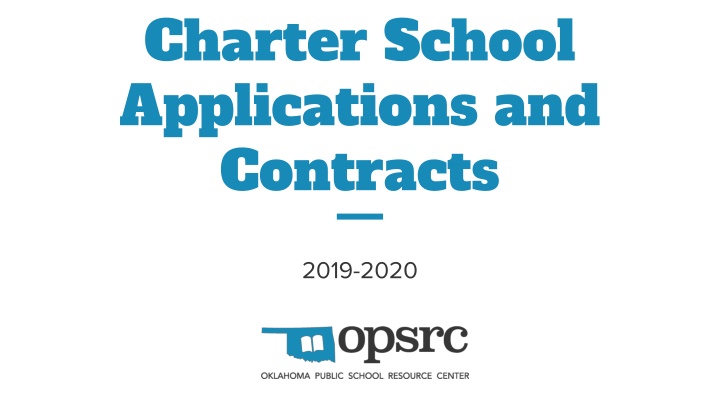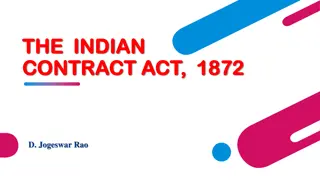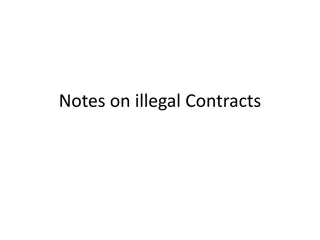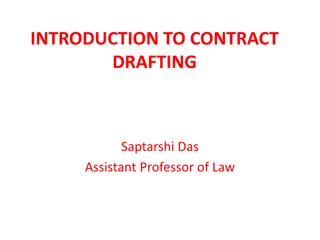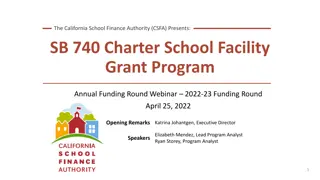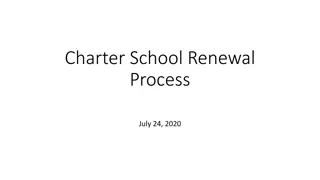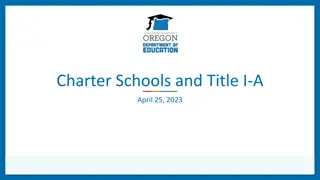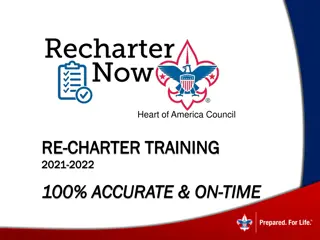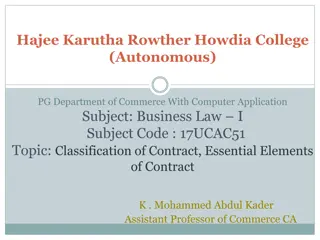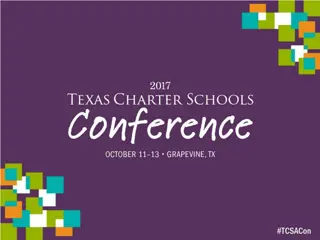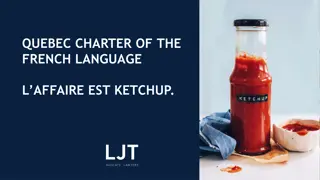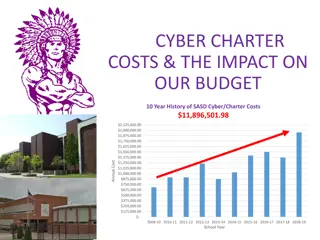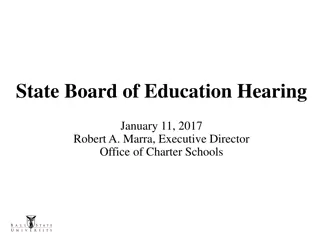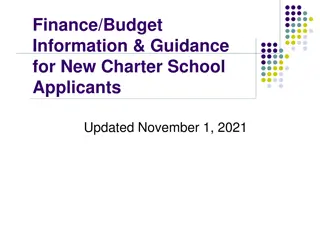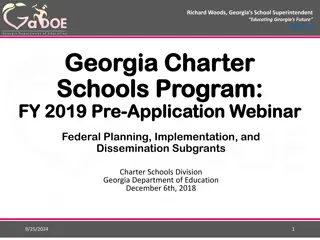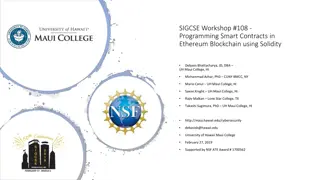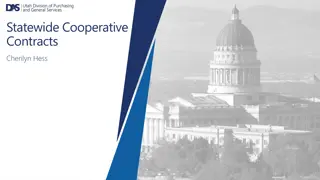Guide to Charter School Applications and Contracts 2019-2020
This detailed guide provides key information on applying for and establishing a charter school, including selecting a sponsor, forming a board, application requirements, common mistakes to avoid, finalizing contracts, accessing charter resources, and securing program grants. It emphasizes the importance of choosing the right sponsor from various entities, such as school districts, universities, Career Techs, State Departments, Native American Tribes, and the Statewide Virtual Charter School Board. Additionally, it highlights the significance of recruiting a diverse founding board and navigating the incorporation process for charter school establishment.
Download Presentation

Please find below an Image/Link to download the presentation.
The content on the website is provided AS IS for your information and personal use only. It may not be sold, licensed, or shared on other websites without obtaining consent from the author.If you encounter any issues during the download, it is possible that the publisher has removed the file from their server.
You are allowed to download the files provided on this website for personal or commercial use, subject to the condition that they are used lawfully. All files are the property of their respective owners.
The content on the website is provided AS IS for your information and personal use only. It may not be sold, licensed, or shared on other websites without obtaining consent from the author.
E N D
Presentation Transcript
Charter School Applications and Contracts 2019-2020
Agenda - Choosing a Sponsor - Recruiting and Forming a Board - Application Requirements - Application Timeline - Common Application Mistakes - Contracts: The Key Final Step - Charter Resources - Charter School Program Grant
Choosing a Sponsor Choosing a sponsor is the first step in the application process. The following entities can sponsor charter schools in the state: - School Districts: Statewide, Public School Districts Can Sponsor a Charter School in their district. - Public Universities: Any Oklahoma public university can sponsor a charter school in Tulsa or Oklahoma County. Public Universities with teacher education programs can Sponsor a school in district where they have a branch campus or constituent agency physically located.
Choosing a Sponsor 2 - Career Techs: Career Techs in Tulsa or Oklahoma county can sponsor a charter in their service area. - State Department: Can sponsor applications from the Office of Juvenile Affairs and can sponsor charter applications that they approve on appeal.
Choosing a Sponsor 3 - Native American Tribes: Can sponsor a charter school in their treaty territory - Statewide Virtual Charter School Board: This is the only entity that can sponsor online/virtual models in the state. It is highly recommended that a charter school applicant work to build a strong professional relationship with their chosen sponsor. This relationship starts when the application is first being drafted.
Recruiting and Forming a Board Your founding board needs to be made up of people from the community that you intend to serve, this is a chance to bring the community in to your school design. - At least 50% of your governing board must live within the boundaries of the district in which your school resides (outside of Tulsa and Oklahoma Counties). - Having members with backgrounds in law and finance can help you as you are working on your application, budget, and contract.
Recruiting and Forming a Board 2 - This board will be subject to open meeting requirements upon the opening of the school, plan accordingly. - The Charter School Leader can NOT be a member of the governance board. (conflict of interest) - Begin your 501(c)3 by incorporating with Secretary of State, and completing the Federal Form 501(C)(3). This will take time.
Application Requirements - Per the Oklahoma Charter School Statute, there are 38 required application components. (see full list of requirements at back of presentation slides.) - This list of requirements is posted in the OPSRC s Charter Resources toolkit (http://opsrc.net/charter/applicants) - Charter sponsors may have additional application requirements. It is strongly recommended that an applicant contact their sponsor to identify any additional application requirements.
Application Timeline Charter Timeline requirements: - Once applicant submits a complete application to the sponsor, the sponsor has 90 days to respond to the application. If denied, the reason(s) for denying must be provided in writing to the applicant. - The applicant has up to 30 days to appeal the decision. The appeal must be sent to the original sponsor.
Application Timeline 2 - The sponsor has 30 additional days to respond to the appeal. - If denied a second time, an applicant has another 30 days to appeal to the State Board of Education and the State Board has up to 60 days to respond to the appeal. The State Board s decision is final. PLEASE NOTE: The timeline listed above refers to the specific statutory requirements. Each charter sponsor may establish a process that modifies this timeline. You should talk to your sponsor to identify any additional deadlines and/or process requirements.
Common Application Mistakes - Board member requirements: A majority of board members must reside in the district boundaries where your charter school will operate. (horseshoe rules do not apply) - Clear governance structure: a Charter is both a Local Education Agency (LEA) AND a non-profit organization (501(c)3). All charter schools are governed by a board of directors.
Common Application Mistakes 2 - Financial plans are often weak - Facility plans are often undefined - Plans to serve ALL students are often undefined. NOTE: Returning students with IEPs and other special needs is NOT acceptable.
Contracts - After a charter school application is approved, the final - and arguably most important - step is finalizing a contract with the sponsor. - The contract will typically use the charter application as a starting point and will define the relationship between the sponsor and the applicant. - It is critical that a charter school have legal counsel available to support these negotiations as the charter contract - NOT the application - is the legally binding document that parties will reference if a dispute arises.
Charter Resources and Next Steps - The Oklahoma Public School Resource Center has a free Charter Resources Page available at: www.opsrc.net/charter-resources/applicant-documents - The resource page includes three sections: resources for charter sponsors, resources for applications, and provides historical documents including all past charter applications and contracts. (Some of these documents are great sleep aids) - Members of the OPSRC receive support on the application and sponsorship side.
Charter School Program Grant The Oklahoma Public School Resource Center (OPSRC) has received a competitive federal grant to carry out the following objectives within Oklahoma: 1. Increase the number of high-quality charter schools in the state with an emphasis on those serving educationally disadvantaged students. 2. Improve student outcomes in Oklahoma charter schools, especially for educationally disadvantaged students. 3. Disseminate best practices.
Subgrants OPSRC will award 5 subgrants per year for new brick-and- mortar charter schools based on models that have been proven to successfully increase student achievement, especially for educationally disadvantaged students or to those seeking to expand/replicate existing high-quality charter schools. These funds are for start up expenses only. Subgrants of $900,000: $250,000 in the Planning Year. $650,000 in the Implementation Year.
Eligible Applicants Grant applicants must conform to the federal definition of a public charter school in the Elementary and Secondary Education Act [P.L. 114-95, section 4310(2)] to be eligible for grant funds under the CSP Grant. To be eligible to apply, a public charter school must be governed by a non-profit board that is separate from the sponsoring board and may not be composed of voting members from the authorizing board of directors. Virtual charter schools are not eligible to apply.
Eligible Applicants 2 All applicants for the CSP Grant must have: an executed charter with a sponsor, must be no more than 16 months from opening as of the due date of the Subgrant. Charter schools in operation, approved charter schools that are more than 16 months from opening, and developers that have not yet been approved by a sponsor are not eligible to apply. Grant activities may not extend beyond the first year of operation.
Questions? Eric Doss eric.doss@opsrc.net 918-236-8770 Feel free to contact Us at OPSRC!
